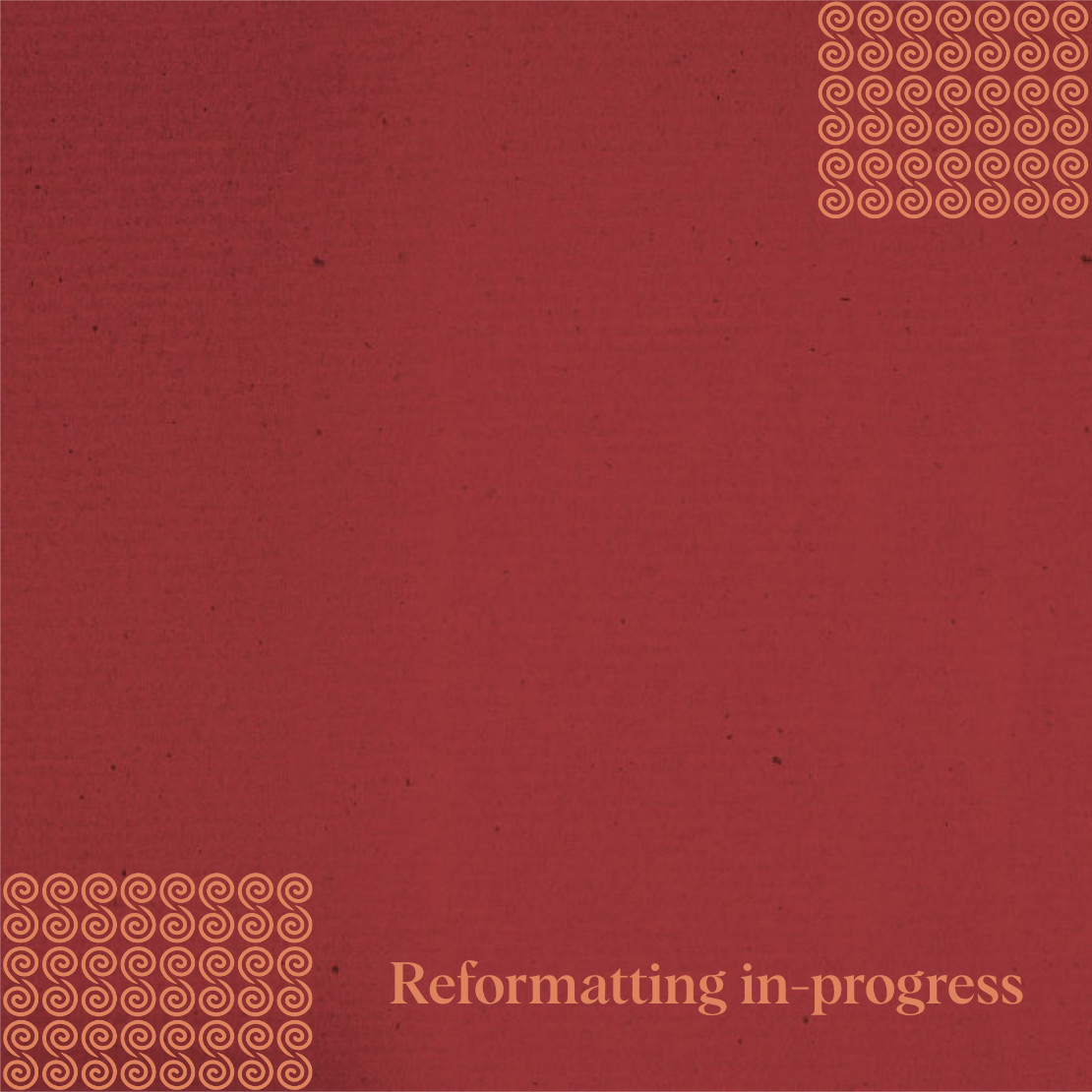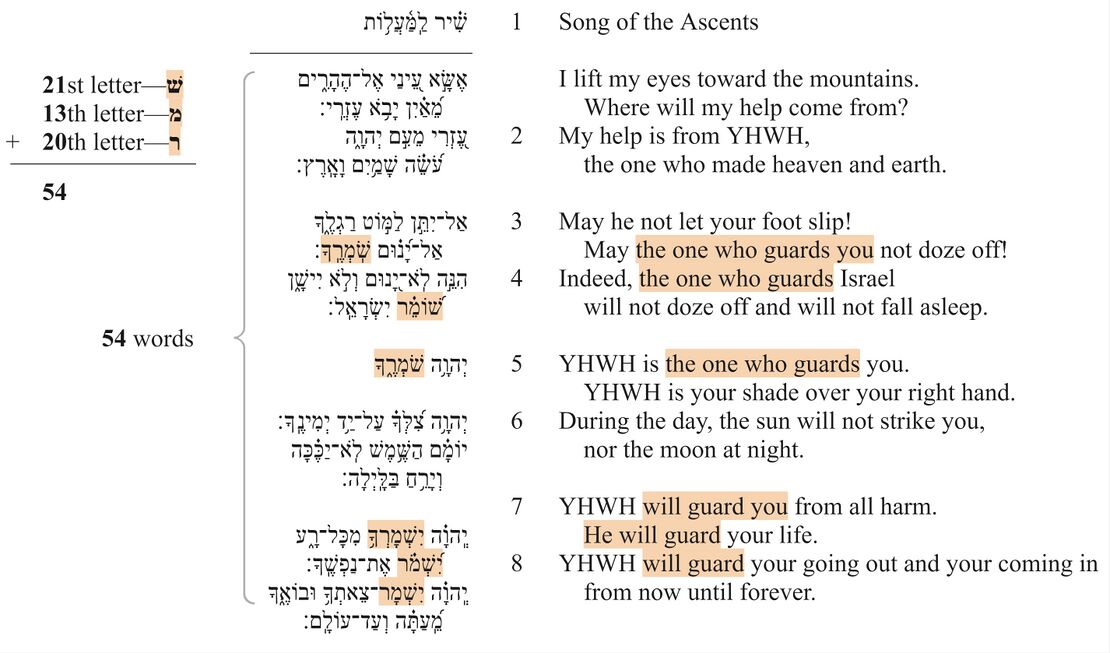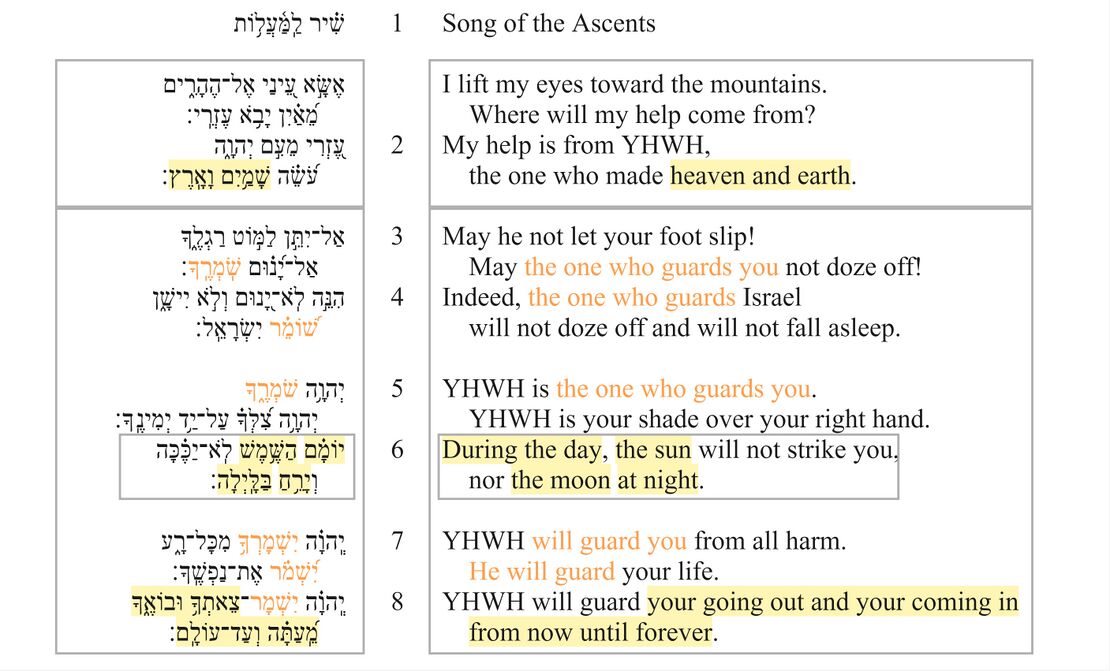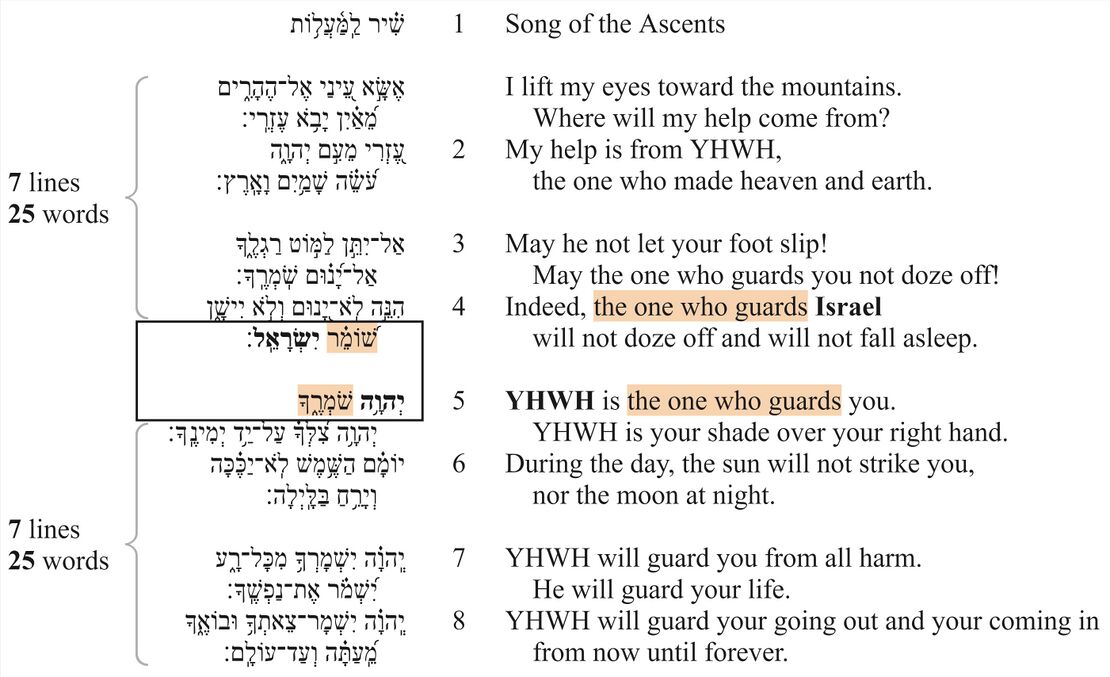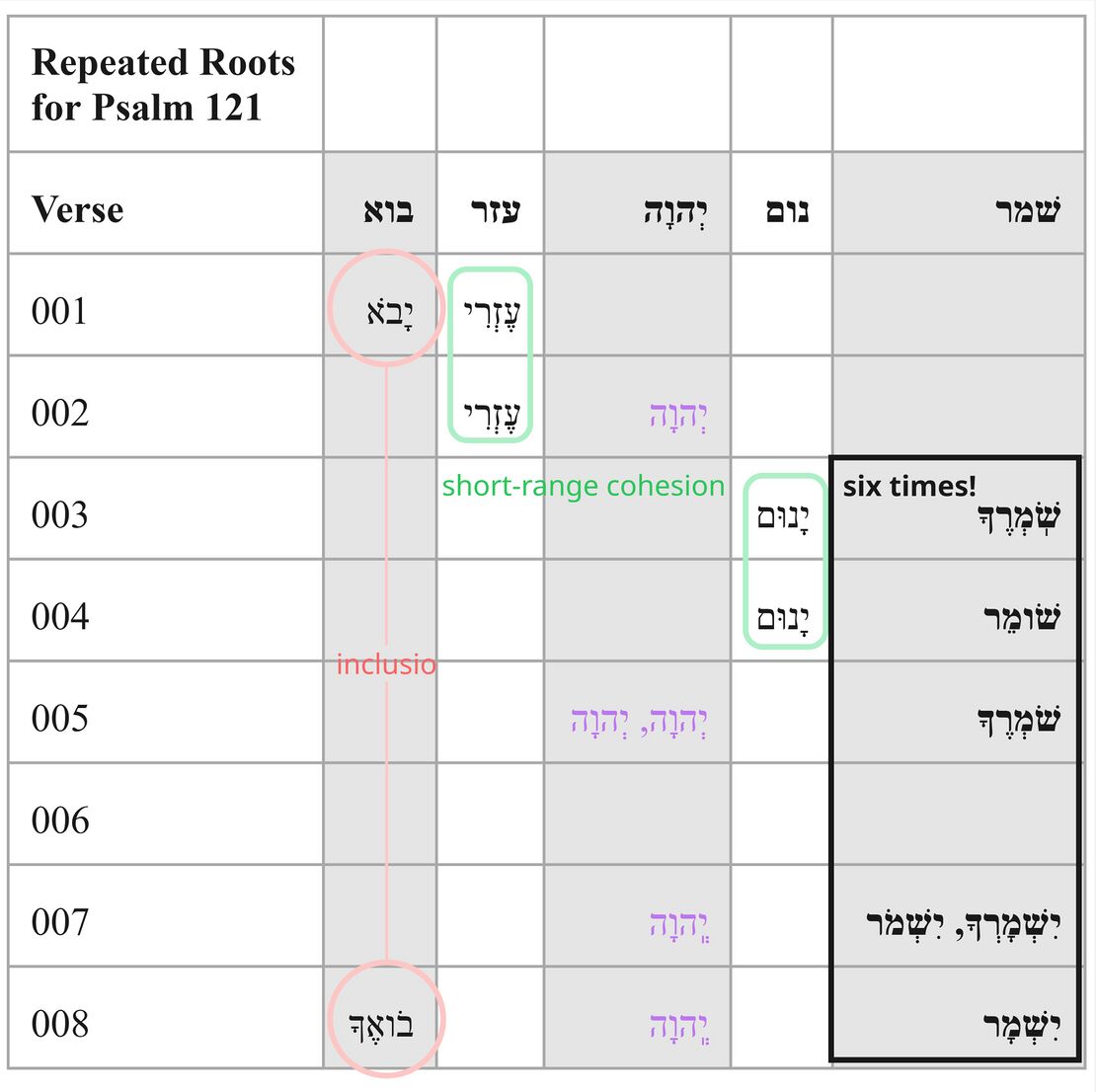Psalm 121 Poetic Features
Poetic Features
In poetic features, we identify and describe the “Top 3 Poetic Features” for each Psalm. Poetic features might include intricate patterns (e.g., chiasms), long range correspondences across the psalm, evocative uses of imagery, sound-plays, allusions to other parts of the Bible, and various other features or combinations of features. For each poetic feature, we describe both the formal aspects of the feature and the poetic effect of the feature. We assume that there is no one-to-one correspondence between a feature’s formal aspects and its effect, and that similar forms might have very different effects depending on their contexts. The effect of a poetic feature is best determined (subjectively) by a thoughtful examination of the feature against the background of the psalm’s overall message and purpose.
The One Who Guards
If an emendation or revocalization is preferred, that emendation or revocalization will be marked in the Hebrew text of all the visuals.
| Emendations/Revocalizations legend | |
|---|---|
| *Emended text* | Emended text, text in which the consonants differ from the consonants of the Masoretic text, is indicated by blue asterisks on either side of the emendation. |
| *Revocalized text* | Revocalized text, text in which only the vowels differ from the vowels of the Masoretic text, is indicated by purple asterisks on either side of the revocalization. |
Feature
The word "guard" (שׁמר) occurs six times in this short eight-verse psalm (vv. 3, 4, 5, 7, 8).
The psalm has 54 words.[1] (Note that this word count excludes the superscription and disregards the maqqefs in the Masoretic Text and counts each individual grapheme as its own word.) The number 54 corresponds to the numerical value of the word שׁמר, if each letter in the word is assigned a value according to its position in the Hebrew alphabet.
Shin (שׁ) is the 21st letter of the alphabet Mem (מ) is the 13th letter of the alphabet Resh (ר) is the 20th letter of the alphabet.
21 + 13 + 20 = 54.
(Note that shin [שׁ] and sin [שׂ] are not counted as separate letters in the biblical acrostic poems.)
Effect
The word שׁמר is, by far, the most prominent word in this poem. Not only is it repeated six times within such a short span of text, but the numerical value of this word has determined the exact length of the poem. It is clear that the poet wants his readers to remember this idea above all: YHWH guards his people.
Anywhere, Anytime
If an emendation or revocalization is preferred, that emendation or revocalization will be marked in the Hebrew text of all the visuals.
| Emendations/Revocalizations legend | |
|---|---|
| *Emended text* | Emended text, text in which the consonants differ from the consonants of the Masoretic text, is indicated by blue asterisks on either side of the emendation. |
| *Revocalized text* | Revocalized text, text in which only the vowels differ from the vowels of the Masoretic text, is indicated by purple asterisks on either side of the revocalization. |
Feature
Psalm 121 contains several merisms.[2]
1. "heaven and earth" (v. 2) 2. "during the day... at night" (v. 6) 3. "sun... moon" (v. 6) 4. "your going out and your coming in" (v. 8a) 5. "from now until forever" (v. 8b)
Furthermore, these merisms occur at key structural points in the text. The first merism concludes the first main part of the psalm (v. 2, see poetic Structure), and the last two merisms conclude the psalm as a whole (v. 8). The second and third merisms both occur in v. 6, which stands out as a central verse in the main body of the psalm (vv. 3–8) – it is the only verse in this section that does not have the word "guard" (שׁמר), with this word occurring three times before this verse and three times after it. Verse 6 is also structured as an elaborate chiasm: a. "during the day" b. "sun" c. "will not strike you" b. "moon" a. "at night"
Effect
The use of merisms at strategic points in the text highlights the all-encompassing nature of YHWH's protection.
As the one who made the whole universe (v. 2: "heaven and earth"), YHWH is able to guard his people from every heavenly power (v. 6: "sun... moon") at every moment of the day (v. 6: "during the day... at night") in all that they do (v. 8a: "your going out and your coming in") for all of time (v. 8b: "from now until forever").
YHWH Guards Israel
If an emendation or revocalization is preferred, that emendation or revocalization will be marked in the Hebrew text of all the visuals.
| Emendations/Revocalizations legend | |
|---|---|
| *Emended text* | Emended text, text in which the consonants differ from the consonants of the Masoretic text, is indicated by blue asterisks on either side of the emendation. |
| *Revocalized text* | Revocalized text, text in which only the vowels differ from the vowels of the Masoretic text, is indicated by purple asterisks on either side of the revocalization. |
Feature
The numeric center of the psalm is vv. 4b–5a. These two lines are flanked on either side by seven lines and 25 words.
These two lines are exceptionally short – the two shortest lines in the psalm in terms of word and syllable count (2 words, 5–6 syllables). (The only other two-word line is v. 6b. In terms of syllables, this line is slightly longer than the lines in vv. 4b–5a.)
These two lines form a chiasm:
a. "one who guards" b. "Israel" (proper name) b. "YHWH" (proper name) a. "one who guards"
(Note also the theophoric element in the name "Israel" [אל = "God"], which further strengthens the chiastic connection between "Israel" and "YHWH").
Effect
The centrality of vv. 4b–5a brings into sharp focus the psalm's main theme ("guarding") and its two main participants ("Israel" and "YHWH"). The whole message of the psalm can be summarized with these few words: "YHWH guards Israel."
Repeated Roots
The repeated roots table is intended to identify the roots which are repeated in the psalm.
| Repeated Roots legend | |
|---|---|
| Divine name | The divine name is indicated by bold purple text. |
| Roots bounding a section | Roots bounding a section, appearing in the first and last verse of a section, are indicated by bold red text. |
| Roots occurring primarily in the first section are indicated in a yellow box. | |
| Roots occurring primarily in the third section are indicated in a blue box. | |
| Roots connected across sections are indicated by a vertical gray line connecting the roots. | |
| Section boundaries are indicated by a horizontal black line across the chart. | |
